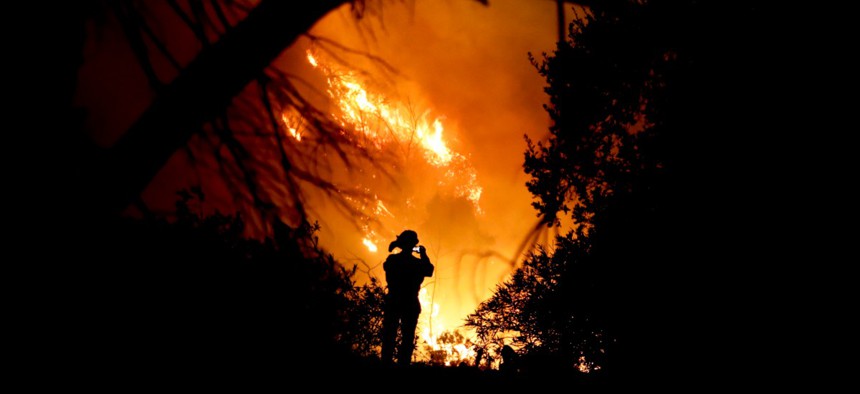Watchdog: IT Troubles Limited FEMA’s Response to 2017 Hurricanes, Wildfires

A firefighter takes a cell phone picture during a wildfire Saturday, Dec. 16, 2017, in Montecito, Calif. Chris Carlson/AP
The flaws, some of which date back more than a decade, left first responders scrambling to gather, share and access critical information.
Shoddy IT and poor leadership hurt the Federal Emergency Management Agency’s ability to respond to a string of devastating hurricanes and wildfires in 2017, according to an internal watchdog.
In 2017, FEMA found itself responding to destruction on a historic scale. As hurricanes Harvey, Irma and Maria slammed the Gulf Coast and Eastern Seaboard, and wildfires burned for months in California, the agency’s outdated tech couldn’t keep up with the workload, according to the Homeland Security Inspector General.
In a recent report, auditors highlighted numerous flaws in the FEMA’s IT infrastructure that left first responders scrambling to gather, share and access critical information. As a result, personnel were often forced to use manual workarounds and ad-hoc processes to allocate resources and collect data on survivors, and in many cases, they relied on personal laptops and smartphones to complete their work, according to the IG.
“Working in this manner increases the risk that disaster assistance and grants could be delayed and duplication of benefits could occur,” auditors said.
The shortcomings, some of which were brought to light more than a decade ago, are the result of years of shoddy IT management, auditors said. FEMA hasn’t published an IT strategic plan since 2013, and it lacks an enterprise architecture to govern its IT environment, according to the IG.
The agency’s stagnated modernization efforts are further hampered by insufficient tech budgets and the limited authorities of its chief information officer, auditors said.
The report comes as climate change threatens to make hurricanes, wildfires and other natural disasters more frequent and fearsome in the years ahead.
“Without progress in these areas, personnel will remain dependent on outdated and unintegrated legacy systems, inadequate equipment, and alternative solutions … to accomplish critical disaster response and recovery operations,” they wrote.






